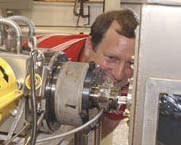 |
|
The Right Touch by Mike Perricone Scintillating plastic is the lightning rod of a particle detector, collecting the energy from particle collisions, converting it into light and transporting the light to electronic readouts for transformation into digital signals that produce scientific data. Few particle physics experiments could exist without it. Like virtually every piece of equipment in high-energy physics research, the new 70-foot extruder for scintillating plastic at Lab 5 offers new prospects for using everyday materials in the search for discoveries in the science of matter, energy, space and time. And like virtually every piece of equipment in highenergy physics research, the new 70-foot extruder will make its contributions because of technicians and operators who have used their skill, experience and savvy to get it delivered, set up and running.
The $550,000 assemblage of mixers, dies, and cooling tanks for turning molten mixtures into precision plastic was funded by Northern Illinois University and sited at Fermilab for the Northern Illinois Center for Accelerator and Detector Development. "Fermilab is a world-class research facility, and NIU now has the equipment to produce novel scintillating detectors, so the collaboration makes perfect sense," said NIU physicist and NICADD codirector Jerry Blazey, who also serves as cospokesperson at DZero. The millions of feet of scintillating plastic required for such experiments as the Main Injector Neutrino Oscillation Search (MINOS) will still be made for the lab by commercial firms. But trying out new methods and materials could run $1,500 a day on similar equipment at a commercial firm. The Lab 5 extruder is a research tool, aimed at producing data on different scintillator compositions, and developing ways to improve production. The NIU Mechanical Engineering Department will provide two professors and several students to work on designs for extrusion dies and to develop software packages for simulating the fluid flow. "It's a great tool for students," said materials scientist Anna Pla-Dalmau, leader of PPD's Scintillation Detector Development group and a specialist in scintillator for her 16 years at the lab. "It offers students a specific hands- on approach. They can run simulations, and they can see what comes out of the die." But setting up the assembly line and handling the plastic that runs through it are tasks reserved for the seasoned pros like technicians Zimmerman and Chuck Serritella. "When the machinery was delivered in February, there were so many mechanical and electronic challenges," said research scientist Viktor Rykalin of NIU, who coordinates the R&D effort for NICADD. "Jerry and Chuck did incredible work to get this apparatus up and running." What was the biggest challenge? "I can't think of one big doozie, just lots of middlesized ones," Zimmerman said. "Setting up the dryer was maybe the biggest, since it was taller then the crane in the building. The riggers had to use a multistep approach to get it on to the platform." Followed by a multistep approach to get it running smoothly, from pellets dropped down a funnel to precise scientific instrumentation appearing at the other end. "By being involved with every aspect of the installation and setup," Zimmerman said, "we've learned almost every square inch of the machine. We can apply that knowledge to getting the best plastic. Our job as Operator Technicians is to improve the processes, not just do to them." Once the plastic content and feed rate have been decided, and the pellets have been dropped and melted, every inch of the process depends on hands-on skill. Serritella explained that operators wear thick insulated leather gloves that have been soaked in water. The molten plastic begins its trek through the die and the cooling tanks at 200 degrees Celsius. Yet the production demands a fine touch by the operators—even through thick gloves.
"It comes out molten. What you have to do is cut it off, then shape it and feed it into the cooling baths," Serritella said. "You continue feeding it over these rollers in the tanks of cooling water. The whole 70-foot line is done that way. Next there's a tank of water where it's sprayed to cool it more. Then there's an air bath, then it moves into a puller that maintains the shape by pulling at the right rate. But it's a "feel" thing. If you pull too hard, you'll break it and it'll run back down on the floor. If you pull too slowly, it'll jam up and end up on floor again. The machine is coordinated by computer. Hopefully, when you get to the puller, it takes over and pulls at the proper speed. It's still warm but completely solid. You move it onto the table where it's cut to pre-determined lengths." For MINOS, those lengths reached 11 meters (about 35 feet), and Pla-Dalmau said possible lengths are limited only by transportation requirements. The future holds the promise of increased computerization for efficient operation and improved tolerances. "Our goal is to build detectors for the next generation of particle experiments," said Fermilab physicist Alan Bross. Making those detectors for the future of particle physics will always depend on pairs of skilled hands. |
| last modified 7/28/2003 email Fermilab |
FRLsDFx9eyfrPXgV
 "You just don't turn a key and get plastic,"
said Jerry Zimmerman, of the Technical
Centers department in Fermilab's Particle
Physics Division.
"You just don't turn a key and get plastic,"
said Jerry Zimmerman, of the Technical
Centers department in Fermilab's Particle
Physics Division.
